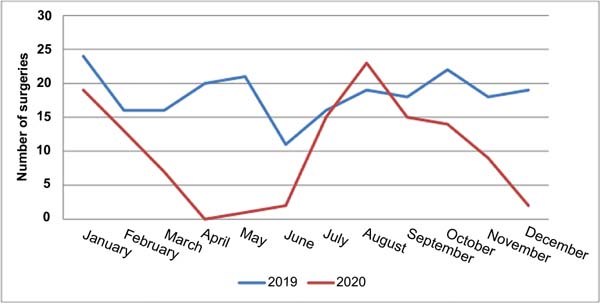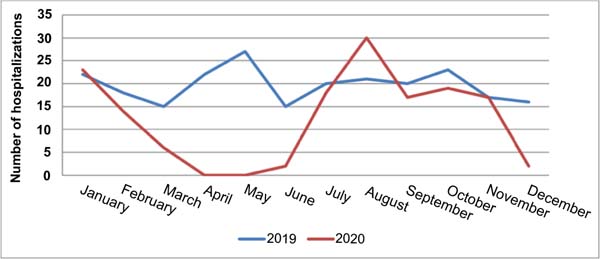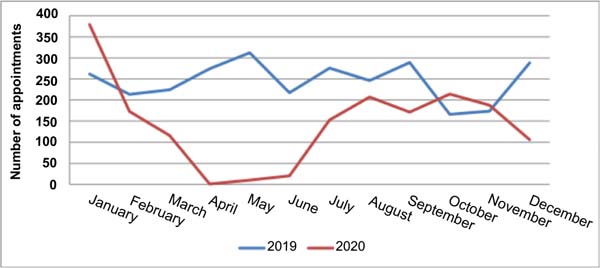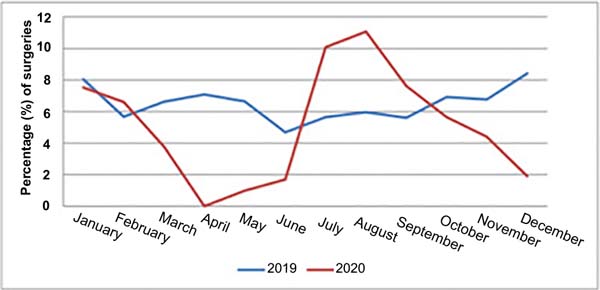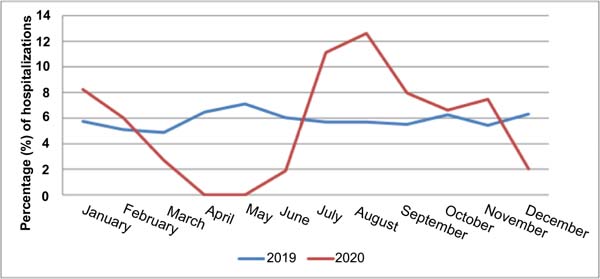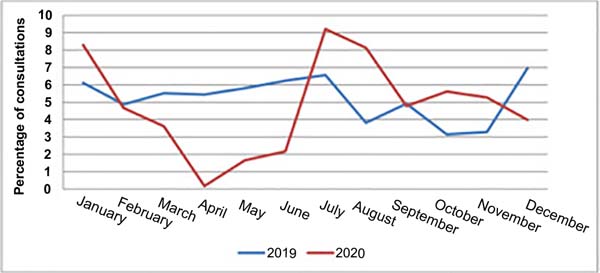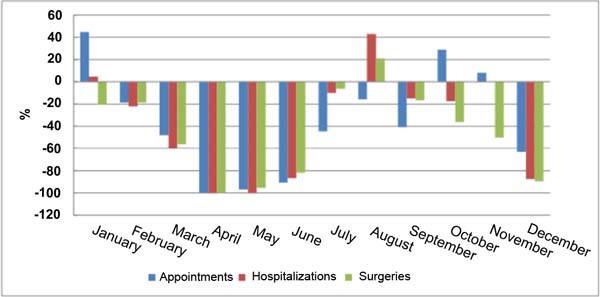INTRODUCTION
Since the beginning of the COVID-19 pandemic, the world has faced major
challenges to contain its advance, elucidate its treatment and adapt to the
impacts generated on health, education, and the economy. The event was first
publicized in November 2019 in Wuhan, China. In March 2020, the World Health
Organization (WHO) declared a public health emergency of international concern
regarding this viral pathogen1.
The Ministry of Health confirmed the first case in Brazil on February 26,
20202,3.
Almost all medical specialties adapted their routine and procedures to face the
emerging challenge, postponing non-essential and outpatient consultations, which
resulted in a sharp reduction in elective surgeries, including in teaching
hospitals4. The CDC
(Centers for Disease Control and Prevention) and the American College of
Surgeons have recommended canceling elective procedures5 in private, public, and academic
settings. To perform the surgeries, preoperative tests, a reduced surgical team,
distancing during intubation and extubation, and complete clothing with personal
protective equipment6 were
indicated.
The Sociedade Brasileira de Cirurgia Plástica (SBCP), on March
16, 2020, recommended the suspension of elective surgeries throughout the
national territory, following the guidelines of the WHO and the Ministry of
Health, aiming to minimize viral transmission and save essential
materials7.
Under normal conditions, the University Hospital Professor Edgard Santos
(C-HUPES) under study, located in the city of Salvador-BA, annually performs
an
average of 308,147 consultations in the various specialties, 550,531 therapeutic
and diagnostic consultations, 9557 hospitalizations, and about 8964
surgeries8. We believe
there is a reduction in these numbers, as seen in the work by Kara et
al.9 and also observed
in the study by Pagotto et al.2, in which there was a significant reduction in plastic surgery
consultations in a Brazilian university hospital at the Faculty of Medicine of
the University of São Paulo compared to pre-pandemic periods in 2019.
In this context, the COVID-19 pandemic did not allow professionals to prepare to
experience it, organizing services for health, financial and educational
impacts. Despite this, studies have shown that, among the surgical specialties,
the lowest risk was presented by plastic surgery, which had no serious
postoperative conditions due to COVID-19, without hospitalizations and
deaths9.
OBJECTIVE
The objective of this study is to evaluate the impact of the COVID-19 pandemic on
the activities of surgical specialties at the University Hospital Professor
Edgard Santos, located in Salvador-BA, as well as to evaluate the impact of the
pandemic on the care of plastic surgery patients and teaching-learning in the
same hospital and period analyzed. The mission of C-HUPES is to be a nationally
recognized institution of excellence in teaching, research, and assistance. Even
with the change in medical training during this period, the concern with the
impacts on practical training could not be disregarded.
METHOD
This is a cross-sectional, retrospective, observational study that compares the
year 2020 to the year 2019, analyzing the impacts of the COVID-19 pandemic on
the activities of the surgical specialties of C-HUPES. The absolute monthly
frequency of surgical procedures, hospitalizations, and outpatient consultations
was evaluated considering the period from January to December 2019 compared to
a
similar period in 2020. In 2020 there was a suspension of activities and a
material crisis, and 2019 was the base year pre-pandemic and material
crisis.
Sample Allocation
This is the population of patients undergoing surgical care at C-HUPES in
2019 and 2020. Data collection was provided by the Care Information
Processing, Monitoring and Evaluation Unit (UPIAMA) and the Surgical Center
Unit. Data were collected and processed through spreadsheets specific to the
sectors of origin.
Materials
Variables analyzed in 2020 compared to 2019:
- Monthly number of outpatient consultations for each surgical
specialty;
- Monthly number of hospitalizations for each surgical specialty;
- Monthly number of surgical procedures performed by each
specialty.
Inclusion criteria
The population of patients attended by the various surgical specialties at
the university hospital in the analyzed period, 2019 and 2020.
Exclusion criteria
Patients not treated by the surgical specialties during the analyzed period
were excluded from the study.
Statistical analysis
Using the electronic spreadsheet (LibreOffice Calc) and population data
extracted from the AGHU Reports program provided by the Surgical Center Unit
and by UPIAMA, the absolute and relative frequencies of surgeries,
hospitalizations, and outpatient consultations, monthly of all surgical
specialties of the C -HUPES comparing the years 2020 and 2019, assessing
whether there was an increase or decrease in activities. The relative
frequency in the percentage of activities performed by plastic surgery
through surgical procedures, hospitalizations, or consultations was also
calculated, comparing this specialty to other surgical specialties and
evaluating the reduction or increase in 2020 compared to 2019.
Ethical aspects
The project was evaluated by the Research Ethics Committee (CEP) of the
Professor Edgar Santos University Hospital of the Federal University of
Bahia following the Guidelines and Regulatory Norms for Research Involving
Human Beings - Resolution 466/12 of the CNS (National Health Council) and
approved under CAAE 52923521.5.0000.0049 published on Plataforma Brasil.
RESULTS
There was a 45.45% reduction in the number of plastic surgeries, with a total of
220 surgeries in 2019 and 120 surgeries in 2020. It is noticed that the worst
period of reduction was from March to June 2020, being in March 56, 25%, April
100%, May 95%, and June 81.82%, and a new fall in November (50%) and December
(89.47%). We noticed recovery from July to October, still with a lower quantity
in 2020 compared to 2019, except for August, when there was a 21.05% increase
in
surgeries (19 procedures in 2019 and 23 in 2020) (Figure 1).
Figure 1 - Number of plastic surgeries performed each month in 2019 (blue
line) and 2020 (red line) at Professor Edgard Santos University
Hospital.
Figure 1 - Number of plastic surgeries performed each month in 2019 (blue
line) and 2020 (red line) at Professor Edgard Santos University
Hospital.
There was a 37.29% reduction in hospitalizations, 236 in 2019 and 148 in 2020. A
reduction in hospitalizations can be seen from March to June and December: in
March, 60%, April 100%, May 100%, June 86.67%, and December 87.5%. In August,
there was a peak in hospitalizations, representing an increase of 42.86% in 2020
compared to 2019 (Figure 2).
Figure 2 - Number of plastic surgery hospitalizations at the University
Hospital Professor Edgard Santos, monthly, in 2019 (blue line) and
2020 (red line).
Figure 2 - Number of plastic surgery hospitalizations at the University
Hospital Professor Edgard Santos, monthly, in 2019 (blue line) and
2020 (red line).
Regarding the number of outpatient consultations, there was a total decrease of
40.90%, as 2941 consultations were carried out in 2019 and 1738 consultations
in
2020. A more abrupt reduction was observed in the periods from March to July,
with a further decrease in December: in March, it reduced by 48.21%; in April,
99.64%; in May, 96.79%; in June, 90.78%; in July 44.57% and in December 63.19%
(Figure 3).
Figure 3 - Number of monthly outpatient plastic surgery consultations in
2019 (blue line) and 2020 (red line).
Figure 3 - Number of monthly outpatient plastic surgery consultations in
2019 (blue line) and 2020 (red line).
Regarding the participation of plastic surgery in the total percentage of
surgeries performed by all surgical specialties of the C-HUPES in the years 2019
and 2020, it is identified that plastic surgery in 2019 had average
participation of 6.49% of the 3390 procedures performed, and in 2020 average
representation of 5.8% of the 2070 procedures performed. In 2020, a large
reduction in participation in plastic surgery can be seen in the period from
March - June and November - December: March representing 3.78%, April 0%, May
0.98%, June 1.69%, November 4.39 %, and December 1.89%. A peak of participation
can also be seen in July at 10.07%, August at 11.06%, and September at 7.61%
(Figure 4).
Figure 4 - Percentage of participation in plastic surgeries concerning the
total number of surgeries performed by all surgical specialties at
Hospital Universitário Professor Edgard Santos in 2019 (blue line)
and 2020 (red line).
Figure 4 - Percentage of participation in plastic surgeries concerning the
total number of surgeries performed by all surgical specialties at
Hospital Universitário Professor Edgard Santos in 2019 (blue line)
and 2020 (red line).
Comparing the participation of plastic surgery in the total percentage of
hospitalizations, it is identified that in 2019 the specialty had an average
participation of 5.85% of the 4035 hospitalizations, and in 2020 an average of
6.55% of the 2258 hospitalizations at C-HUPES. In 2020, the periods with the
lowest contribution of plastic surgery to total hospitalizations were: March
2.69%, April 0%, May 0%, June 1.89%, and December 2.02%. The months with the
greatest contribution of plastic surgery to total hospitalizations were July
and
August, with 11.11% and 12.61% (Figure 5).
Figure 5 - Percentage of plastic surgery hospitalizations concerning total
hospitalizations of all specialties in 2019 and 2020.
Figure 5 - Percentage of plastic surgery hospitalizations concerning total
hospitalizations of all specialties in 2019 and 2020.
Plastic surgery represented 5.09% of the 57,835 outpatient consultations carried
out by all surgical specialties in 2019 and 5.54% of the 31,387 outpatient
consultations in 2020. Also, in 2020, in the periods of greatest decrease,
plastic surgery represented 3.61% in March; 0.18% in April; 1.67% in May; 2.18%
in June, and 3.98% in December. In periods of greater participation, plastic
surgery represented 9.21% in July and 8.14% in August (Figure 6).
Figure 6 - Percentage of plastic surgery consultations concerning the total
number of consultations performed by all specialties in 2019 and
2020.
Figure 6 - Percentage of plastic surgery consultations concerning the total
number of consultations performed by all specialties in 2019 and
2020.
Overall reduction in the number of surgeries (surgical productivity) is
identified in the various specialties of C-HUPES in 2020 compared to 2019. The
3
specialties that achieved the greatest reduction are head and neck surgery, with
a decrease of 71.08%; cardiac surgery, with 68.69%; otorhinolaryngology, with
54.66%. The 3 specialties with the lowest reduction were: pediatric surgery,
with a decrease of 8.91%; vascular surgery, with 22.92%; and gynecological
surgery, with 29.08%. Neurosurgery showed an increase of 3.13% compared to the
previous year. As previously mentioned, plastic surgery had a 45.45% reduction
in surgical productivity (Figure 7).
Figure 7 - Percentage of change in surgical productivity of all specialties
analyzed at Hospital Universitário Professor Edgard Santos,
comparing 2020 to 2019.
Figure 7 - Percentage of change in surgical productivity of all specialties
analyzed at Hospital Universitário Professor Edgard Santos,
comparing 2020 to 2019.
Plastic surgery maintained congruence in the activities provided in the analyzed
period, with similar periods of decline and recovery. It can be seen that the
percentage drop in services provided (outpatient consultations,
hospitalizations, and surgical procedures) occurred from March to June, with
a
recovery period and a smaller percentage drop from July to October. A new period
of percentage decline in all services provided is seen in November and December
(Figure 8).
Figure 8 - Percentage change in plastic surgery activities
(appointments/hospitalizations/surgeries) monthly comparing 2020 and
2019.
Figure 8 - Percentage change in plastic surgery activities
(appointments/hospitalizations/surgeries) monthly comparing 2020 and
2019.
DISCUSSION
The Complexo Hospitalar Universitário Professor Edgard Santos is a highly complex
institution comprising several clinical and surgical specialties, operating
primarily on an elective basis, with a limited number of patients because it
does not have an urgent/emergency service. This hospital was not converted into
an exclusive unit for treating COVID-19; even so, the pandemic brought changes
in the services provided by this institution, in line with reports in the
literature7.
According to Brito et al.10,
due to operating on a primarily elective basis, the surgical specialties of this
institution were affected and changed their medical care since the COVID-19
pandemic had an impact on routines, imposing restrictions in order to reduce
the
spread of the disease and the overload of the health system. However, this
generated losses, as surgical specialties require face-to-face care, which is
essential and cannot be replaced by telemedicine or remote care.
One of the main reasons for delaying elective procedures is the risk of
postoperative complications and a worse prognosis for patients who acquire
COVID-19. However, the concern with practical training could not be disregarded.
The predominant profile of reconstructive surgeries in plastic surgery allowed
the continuity of residents’ procedures, learning, and practice in plastic
surgery, as well as maintenance of care2.
Regarding educational impacts, the study by Mehrzad et al.11 evaluated the changes
experienced by plastic surgery programs as a result of the pandemic in a service
in Turkey, concluding that academic plastic surgery programs had impactful
changes in their operational, educational programming, in teaching and patient
care by identifying the following data: Reduction in the average number of
surgeries to 23% of the total number of surgeries in the pre-COVID periods;
decrease in case volume to approximately 45% of normal and 95.6% reduction in
usual workload.
The plastic surgery service at C-HUPES is made up of 5 assistant professors
providing services in the areas of outpatient surgery, rhinology, palpebral
orbit, post-bariatric reconstructive plastic surgery, hand surgery,
microsurgery, complex reconstructions, body contouring and aesthetic surgeries,
ear reconstructions, eventually breast reconstructions and oncological
reconstructions. This service also has 4 residents per training year (total of
12 residents), selected through a public tender and linked to the Federal
University of Bahia, which has the university hospital and other hospitals
associated with them as fields of practice throughout the academic year.
All C-HUPES patients are treated on an outpatient basis; cases are discussed with
the assistant professors and placed on the agenda according to the waiting list.
Usually, there is a prior surgical appointment and pre-hospitalization notice,
aiming not to have surgeries suspended due to the unavailability of hospital
beds. Surgeries in an urgent/emergency are performed jointly with other
specialties or through internal demand through consultations.
Following global practices, as seen in the work of Chi et al.4, after the start of the
pandemic, essential services were prioritized and elective activities were
canceled or postponed. At the university hospital, these standards were defined
by Technical Note GVIMS/GGTES/ANVISA No. 06/2020 -Guidelines for the prevention
and control of infections by the new coronavirus (SARS-CoV-2) in surgical
procedures6, published
on April 29, 2020, which provided the following information:
”All elective procedures should be carefully reviewed to minimize, postpone, or
cancel non-essential elective surgery, endoscopies, or other invasive procedures
until the inflection point of the epidemiological curve is passed and a trend
stabilizes so that they can be confident that healthcare infrastructure can
support a potentially rapid increase in critical patient care needs.”6 ”The moment of execution and the
risks and benefits of essential and non-essential elective surgical procedures
that may have important sequelae due to non-performance of surgery must be
carefully evaluated.” 6
This GVIMS/GGTES/ANVISA Technical Note No. 06/2020 also provides information on
the resumption of elective surgical procedures:
“It is recommended to resume performing elective surgeries when there is a
sustained reduction in new cases of COVID-19 for at least 14 consecutive days
in
the geographic area, in addition to evaluating other conditions specific to the
health service, such as: Availability of a safe number of hospital beds,
considering beds in intensive care units (ICU) and regular beds and guaranteeing
the existence of PPE, life support equipment and a qualified team to meet the
demand” 6.
In this study, we noticed a significant reduction in surgical activities at the
university hospital from March to July 2020, with a more pronounced reduction
in
April and May, concomitant with the peak periods of the COVID-19 pandemic,
called the first wave, in that there was an absolute restriction on all
non-essential activities, starting on March 16, 2020, with an average duration
of 2 and a half months, until the end of May. There was a further drop in
activities at the end of 2020, in November and December, compatible with the
occurrence of the second wave of the pandemic due to the new viral strain (delta
type), with a peak in infections, hospitalizations, and the need for a new
restriction on non-essential services.
There are increases in surgical activities from July to October, with an increase
in elective hospitalizations, outpatient consultations, and surgical procedures,
showing that the reduction of the pandemic allows the recovery of usual
activities and greater flexibility in the execution of non-essential activities,
as published by Søreide et al.12. In the evaluated hospital, the highest number
of surgeries is attributed to the confluence of the release of elective
procedures, availability of hospital materials, as well as the occurrence of
extra surgical shifts, as seen in August 2020, in which absolute productivity
exceeds the same period of 2019.
In the months in which there were fewer surgeries than hospitalizations, this was
due to the cancellation of elective procedures due to lack of materials (e.g.,
gloves, masks, antisepsis materials, sedatives, and neuromuscular blockers) or
due to the room rotation, in which other more essential or urgent/emergency
procedures were prioritized. In the months in which there were more surgeries
than hospitalizations, this was due to the demand for surgeries on inpatients
(interconsultations), such as patients from the medical clinic, infectology,
ICU
who needed reconstruction of wounds or pressure injuries, or patients addressed
by other surgical specialties, which required the participation of plastic
surgery to close a complex defect2.
In November and December, we noticed a change in the profile of activities. In
November, the number of hospitalizations remained constant. However, with an
abrupt reduction in the number of surgeries, showing surgical cancellations,
in
December, we noticed a significant reduction in surgeries and hospitalizations,
showing new restrictions on elective activities due to the second wave of the
pandemic.
Regarding consultations, periods of critical reduction were observed (from April
to June) due to the acute phase of the first wave of the pandemic and greater
restriction of activities. There is an increase in consultations from July to
October, in line with the improvement of the pandemic and the return to
non-essential activities, with a new period of decline in November and December
- the second wave period. A global reduction in plastic surgery consultations
throughout 2020 is evident compared to 2019. This occurred, in general, probably
due to the reduction in the number of vacancies made available for outpatient
consultations to avoid crowding and less movement of people5.
Comparing plastic surgery to other specialties, we noticed a loss in activities
due to its predominantly elective profile. However, this specialty was not the
most affected in 2020, behind head and neck surgery, cardiac surgery, and
otorhinolaryngology. It is believed that other factors have influenced such as,
for example, the reduction of team members due to illness, leave, or dismissal;
unavailability of special materials that were not prioritized during the
pandemic; reduction in the number of patients since many people did not seek
health services with problems other than COVID-19; or lack of criteria for
surgical indication in the analyzed period13. It is also identified that comparatively, the least
affected specialties were: neurosurgery,
As seen in the work by Pagotto et al.2, which was also carried out in a university hospital, the
C-HUPES had a reduction in the absolute total of services provided by all
surgical specialties, based on the reduction in the frequency of surgeries,
hospitalizations and outpatient consultations of 2020 compared to 2019. In this
context, it is important to highlight that plastic surgery also suffered
reductions and increases in its absolute numbers congruent with the fluctuations
of the pandemic; however, in percentage, in 2020, the specialty maintained the
assistance provided in a similar way to that performed in the previous year,
as
it was responsible for 5.8% of total surgeries, 6.55% of total hospitalizations
and 5.54% of total outpatient consultations, compared to 2019 data: 6.49% of
total surgeries, 5.85% of the total number of admissions and 5,09% of the total
queries.
According to Mehrzad et al.11,
who showed changes in the medical residency program in plastic surgery with a
decrease of approximately 45% of the pre-pandemic normal10, in the plastic surgery
service of C-HUPES it was also identified that the COVID-19 pandemic caused
45.45% reduction in the number of surgeries (100 fewer patients were operated
on
in 2020) and a 40.90% reduction in consultations (1203 fewer outpatient
consultations), showing an important impact on the activities provided by
residents of this service.
Thus, even with data brought by Teitelbaum et al.14, which demonstrated the low risk presented by
plastic surgeries during the pandemic, since there were no severe cases of
COVID-19 in patients in the postoperative period, without deaths or prolonged
hospitalizations, we identified that plastic surgery had a large reduction in
consultations, hospitalizations and surgeries in 2020 compared to 2019.
CONCLUSION
The pandemic impacted the activities of the surgical specialties at C-HUPES,
causing damage to the population, as there was a total reduction (in absolute
numbers) in the number of surgeries, consultations, and hospitalizations
performed in 2020.
The pandemic harmed the care of plastic surgery patients in absolute numbers, as
there was a significant reduction in the total number of surgeries,
hospitalizations, and consultations performed. However, comparing the assistance
provided in 2019, it was noticed that in 2020 plastic surgery maintained a
similar percentage of performance compared to the total activities of all
surgical specialties of C-HUPES.
It is inferred that the COVID-19 pandemic hampered the training of plastic
surgery residents since, in 2020, each plastic surgeon in training operated on
a
smaller number of patients and performed a smaller number of consultations.
1. Universidade Federal da Bahia, Serviço de
Cirurgia Plástica do Hospital Universitário Professor Edgard Santos, Salvador,
BA, Brazil
2. Universidade Federal da Bahia, Serviço de
Cirurgia Plástica do Hospital Universitário Professor Edgard Santos,
Departamento de Anestesiologia e Cirurgia, Salvador, BA, Brazil
3. Universidade Federal da Bahia, Faculdade de
Medicina da Bahia, Salvador, BA, Brazil
Corresponding author: Antonio Oliveira Lima Neto
Rua Leonor Calmon, 44, salas 1001 e 1002, Empresarial Cidade Jardim, Candeal,
Salvador, BA, Brazil., Zip Code: 40296-210, E-mail:
antonio_olimaneto@yahoo.com.br



